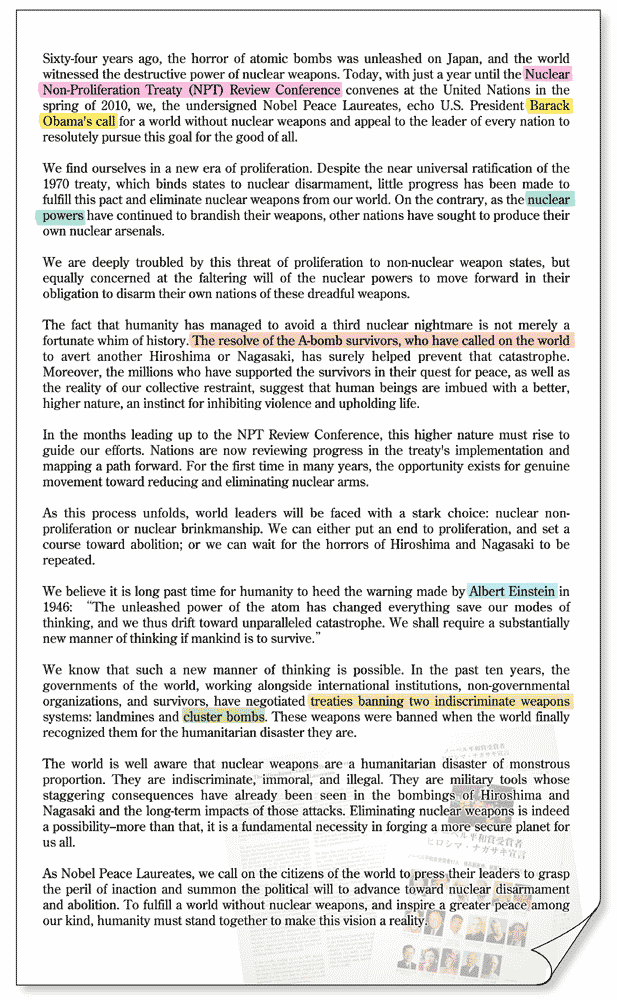Read the Hiroshima-Nagasaki DeclarationThe passion of 17 Nobel Peace Prize laureates
U.S. President Barack Obama has been chosen as the Nobel Peace Prize laureate for 2009. The award ceremony will take place in Oslo, Norway in December.
For this issue, the junior writers have studied the Hiroshima-Nagasaki Declaration of Nobel Peace Laureates that was issued by the Chugoku Shimbun in May to support the aim of nuclear abolition. In this statement, released in the run-up to next May's Nuclear Non-proliferation Treaty (NPT) Review Conference, 17 Nobel Peace laureates have called for the elimination of nuclear weapons from the world.
Some of the junior writers weren't even aware that this declaration existed, and some parts of the text were difficult for us to understand. However, studying more about the conditions involving nuclear weapons and the background of the statement made us realize the importance of this appeal.
We also considered ways to heighten the impact of the declaration. With only six months remaining until the NPT Review Conference, we hope the declaration can be an important step toward nuclear abolition.
|
The full text of the Hiroshima-Nagasaki Declaration of Nobel Peace Laureates By clicking the highlighted areas, you can read more explanation about them.
(Moeko Takagi, 15 and Mako Sakomoto, 13 provided this explanation) 
|
|
The Hiroshima-Nagasaki Declaration was released in May 2008 by 17 Nobel Peace Laureates with the aim of arousing public opinion in the run-up to the NTP Review Conference, scheduled for May 2010 at United Nations Headquarters in New York. Màiread Corrigan-Maguire, a peace activist from Northern Ireland, proposed creating the declaration. She was awarded the Nobel Peace Prize in 1976 for her role in pursuing a peaceful settlement to the conflict in Northern Ireland. In December 2008, she met Akira Tashiro, the executive director of the Hiroshima Peace Media Center, at an international conference in France, and they talked about the idea. The declaration was drafted through an exchange of email by Ms. Maguire and other women laureates. They then called on all Peace Prize laureates--30 were still living at the time--to endorse the declaration. In response, Wangari Maathai, a Kenyan environmental and political activist, and The Dalai Lama were among those who signed the statement. In addition to newspapers in Japan and international news sites online, the Hiroshima-Nagasaki Declaration was introduced in the Japanese Diet and the United Nations Disarmament Conference in Niigata. Awareness of the declaration seems to be gradually growing in the world. Mr. Tashiro commented, "After reading the declaration, we hope each person will reflect on the abolition of nuclear weapons and take action, such as writing letters to government figures or folding paper cranes." (Shotaro Takata, 15) |
Our proposals regarding the Hiroshima-Nagasaki Declaration
(1)Call for other Nobel laureates to endorse the statement So far, only Nobel Peace Prize laureates have signed the Hiroshima-Nagasaki Declaration. We think it would be a good idea to ask other Nobel laureates to sign it, too. Physics and chemistry are connected to the production of nuclear weapons so it might have some impact if the laureates in these fields vow that science should not be used to continue developing such weapons. If Nobel laureates in literature and medicine, too, could endorse the declaration, this would also widen its appeal. (2)Make an appeal at the Nobel Peace Prize Ceremony U.S. President Barack Obama has been awarded this year's Nobel Peace Prize. If the Hiroshima-Nagasaki Declaration could be introduced at the ceremony in Oslo, Norway in December, Mr. Obama might also be inclined to endorse it. This would not only increase the number of signatures, it would raise awareness of the declaration among many people. Then, each year, the new laureate's signature could be added. If President Obama signs the declaration, and if he visits Hiroshima, this could accelerate the momentum for the abolition of nuclear weapons. (3)Display the declaration at Hiroshima Peace Memorial Museum Some of the junior writers hadn't heard about the Hiroshima-Nagasaki Declaration. We suppose many adults don't know about it, either. To raise awareness of the statement, perhaps Hiroshima Peace Memorial Museum could display a panel about it. At the museum, visitors can learn about the aftermath of the atomic bombing and the cruelty of nuclear weapons. After seeing these exhibits, reading about the declaration would let people know that the world is taking action to advance the cause of nuclear abolition. They might also think: "We should take action, too." Peace Memorial Museum welcomes a large number of visitors from Japan and overseas, so this would be a good opportunity to let people know about the declaration. We hope the museum will be a place that promotes nuclear abolition as well as a place for learning about the tragedy of the past. (4)Call for the support of citizens The support of Nobel Peace Prize laureates gives impact to the Hiroshima-Nagasaki Declaration, but ordinary citizens could offer support to it, too. For example, signatures could be collected in support of the statement. By calling for signatures from the member countries of Mayors for Peace, a great number of signatures could be collected. The signatures could then be delivered to the NPT Review Conference next year to appeal for more cooperation for nuclear abolition. (5)Junior writers can work in cooperation The junior writers in Hiroshima could join hands with other junior writers, such as those in Japan and overseas and participants in the annual International Youth Media Summit, to broaden coverage of the Hiroshima-Nagasaki Declaration. This would contribute to raising awareness of the declaration among the world's youth. (Akane Murashige, 16, Yuki Sakata,16, Yuka Iguchi,14 and Yumi Kimura,14) |